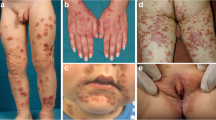Abstract
Background
The clinical and pathological aspects of fixed drug eruption (FDE) have been described based on a few case series.
Objectives
To compare bullous FDE (BFDE) and non-bullous FDE (NBFDE) and to determine whether BFDE can be histologically distinguished from other dermatoses presenting with an apoptotic pan-epidermolysis.
Materials & Methods
In this retrospective monocentre study (2005–2016), FDE was classified as BFDE or NBFDE and localized (one anatomical site) or generalized (≥ two sites; GBFDE). Clinical data were extracted from charts, and images were reviewed. Skin biopsies were analysed and compared to the clinical presentation. Three dermatopathologists, blinded to the final clinical diagnosis, evaluated a subset of BFDE cases (n = 8) and 25 biopsies of other bullous diseases known to have an epidermal necrolysis (EN)-like pattern. In total, 73 patients were included in the study.
Results
Patients with BFDE (n = 58; GBFDE n = 48) were significantly older (p < 0.001). All patients with GBFDE were hospitalized; 25 had a complication (infectious; n = 19), and eight died (median age: 80). Histology revealed spongiotic (6.7%), interface dermatitis (48.3%) and EN-like (66.3%) patterns. The EN-like pattern was more frequent in BFDE than NBFDE (74% vs 27%; p = 0.008). Melanophages (100% vs 66%; p = 0.02) and massive dermal melanosis (40% vs 4%; p = 0.0005) were more prominent in NBFDE than BFDE. BFDE could not be reliably distinguished from other bullous diseases with EN-like patterns.
Conclusion
BFDE belongs to the spectrum of skin conditions with an EN pattern, for which the concept of acute syndrome of apoptotic panepidermolysis (ASAP) was previously introduced. Clinical-pathological correlation is mandatory for a diagnosis of BFDE.
Similar content being viewed by others
References
Brahimi N, Routier E, Raison-Peyron N, et al. A three-year-analysis of fixed drug eruptions in hospital settings in France. Eur J Dermatol 2010; 20: 461–4.
Valeyrie-Allanore L, Lebrun-Vignes B, Bensaid B, Sassolas B, Barbaub A, & sous l’égide du groupe toxidermie de la Société française de dermatologie (FISARD). Fixed pigmented erythema: Epidemiology, physiopathology, clinical features, differential diagnosis and therapeutic management. Ann Dermatol Venereol 2015; 142: 701–6.
Shelley WB, Shelley ED. Nonpigmenting fixed drug eruption as a distinctive reaction pattern: examples caused by sensitivity to pseudoephedrine hydrochloride and tetrahydrozoline. J Am Acad Dermatol 1987; 17: 403–7.
Andrade P, Brinca A, Gonçalo M. Patch testing in fixed drug eruptions-α 20-year review. Contact Dermatitis 2011; 65: 195–201.
Tsuruta D, Sowa J, Kobayashi H, Ishii M. Fixed food eruption caused by lactose identified after oral administration of four unrelated drugs. J Am Acad Dermatol 2005; 52: 370–1.
Volz T, Berner D, Weigert C, Röcken M, Biedermann T. Fixed food eruption caused by asparagus. J Allergy Clin Immunol 2005; 116: 1390–2.
Cho Y-T, Lin J-W, Chen Y-C, et al. Generalized bullous fixed drug eruption is distinct from Stevens-Johnson syndrome/toxic epidermal necrolysis by immunohistopathological features. J Am Acad Dermatol 2014; 70: 539–48.
Lipowicz S, Sekula P, Ingen-Housz-Oro S, et al. Prognosis of generalized bullous fixed drug eruption: comparison with Stevens-Johnson syndrome and toxic epidermal necrolysis. Br J Dermatol 2013; 168: 726–32.
Kavoussi H, Rezaei M, Derakhshandeh K, et al. Clinical Features and Drug Characteristics of Patients with Generalized Fixed Drug Eruption in the West of Iran (2005–2014). Dermatol Res Pract 2015; 2015: 236703.
Weinborn M, Barbaud A, Truchetet F, Beurey P, Germain L, Cribier B. Histopathological study of six types of adverse cutaneous drug reactions using granulysin expression. Int J Dermatol 2016; 55: 1225–33.
Mizukawa Y, Shiohara T. Nonpigmenting fixed drug eruption as a possible abortive variant of toxic epidermal necrolysis: immunohistochemical and serum cytokine analyses. Clin Exp Dermatol 2010; 35: 493–7.
Shiohara T, Mizukawa Y. Fixed drug eruption: a disease mediated by self-inflicted responses of intraepidermal T cells. Eur J Dermatol 2007; 17: 201–8.
Duong TA, Valeyrie-Allanore L, Wolkenstein P, Chosidow O. Severe cutaneous adverse reactions to drugs. Lancet 2017; 390: 1996–2011.
Ting W, Stone MS, Racila D, Scofield RH, Sontheimer RD. Toxic epidermal necrolysis-like acute cutaneous lupus erythematosus and the spectrum of the acute syndrome of apoptotic pan-epidermolysis (ASAP): a case report, concept review and proposal for new classification of lupus erythematosus vesiculobullous skin lesions. Lupus 2004; 13: 941–50.
Amode R, Ingen-Housz-Oro S, Ortonne N, et al. Clinical and histologic features of Mycoplasma pneumoniae-related erythema multiforme: A single-center series of 33 cases compared with 100 cases induced by other causes. J Am Acad Dermatol 2018; 79: 110–7.
Gaudin O, Toukal F, Hua C, et al. Association Between Severe Acute Contact Dermatitis Due to Nigella sativa Oil and Epidermal Apoptosis. JAMA Dermatol 2018; 154: 1062–5.
Ortonne N, Valeyrie-Allanore L, Bastuji-Garin S, et al. Histopathology of drug rash with eosinophilia and systemic symptoms syndrome: a morphological and phenotypical study. Br J Dermatol 2015; 173: 50–8.
Mizukawa Y, Yamazaki Y, Shiohara T. In vivo dynamics of intraepidermal CD8+ T cells and CD4+ T cells during the evolution of fixed drug eruption. Br J Dermatol 2008; 158: 1230–8.
Mizukawa Y, Yamazaki Y, Teraki Y, et al. Direct evidence for interferon-gamma production by effector-memory-type intraepidermal T cells residing at an effector site of immunopathology in fixed drug eruption. Am J Pathol 2002; 161: 1337–47.
Skowron F, Bensaid B, Balme B, et al. Comparative histological analysis of drug-induced maculopapular exanthema and DRESS. J Eur Acad Dermatol Venereol 2016; 30: 2085–90.
Acknowledgements and disclosures
Acknowledgements: Emilie Perron gratefully acknowledges the “Bourse du doyen McLaughlin de la Faculté de Médecine” (Laval University) and the TEVA Canada Innovation fellowship grant. She thanks Dr. Francois Thériault-Proulxfor revising the manuscript many times over and lengthy discussions. Financial support: none. Conflicts of interest: none.
Author information
Authors and Affiliations
Corresponding author
About this article
Cite this article
Perron, E., Viarnaud, A., Marciano, L. et al. Clinical and histological features of fixed drug eruption: a single-centre series of 73 cases with comparison between bullous and non-bullous forms. Eur J Dermatol 31, 372–380 (2021). https://doi.org/10.1684/ejd.2021.4051
Accepted:
Published:
Issue Date:
DOI: https://doi.org/10.1684/ejd.2021.4051




